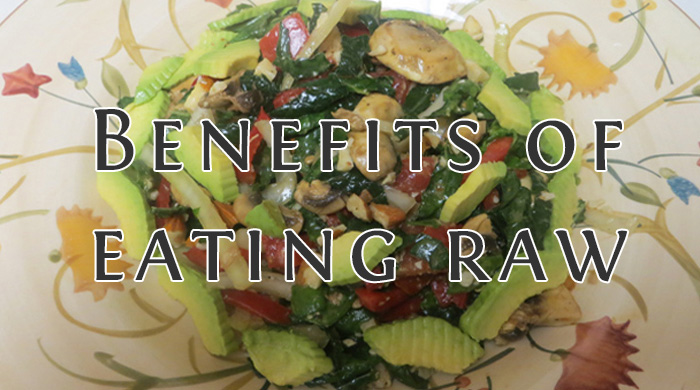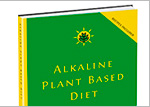Eating Raw Is Good But You Should Have Balance

Eating raw plant food is good because that would mean eating lots of fruits and vegetables, and some nuts and seeds. These foods provide lots of nutrients to support a healthy body.
In the most literal sense a person eating raw would not consume cooked food. He would eat fruits and vegetables, and nuts and seeds because they don’t require cooking.
On the other hand he would avoid consuming grains because he would have to cook them. But should you avoid all grains in a balanced diet?
Let’s look into eating raw, its benefits, and if we should eat a completely raw vegan diet.
Definition Of Eating Raw
Eating raw for most people doesn’t mean you wouldn’t eat any cooked food. It would mean you wouldn’t eat food cooked over 105 degrees Fahrenheit. But in the literal sense you wouldn’t add heat at all, which would also include no steaming.
People who use the practical “below 105 degrees Fahrenheit” definition for eating raw do so because cooking below this temperature preserves the plant’s enzymes.
This allows you to keep the plant’s nutrients intact, which aids in its digestion. Both the literal and practical terms result in preserving the plant’s enzymes.
Does Eating Raw Plant Enzymes Matter?
Plants use enzymes to break down their protein, carbohydrates, and fats as they ripen. When people eat raw plant food they break apart the plant’s cell walls. This releases enzymes that aid with their digestion.
Though this is helpful in the digestive process, the body already relies heavily on enzymes it produces that do the same job. Since the body produces its own enzymes that digest plants, some people argue that it is not necessary to preserve all of the plant’s enzymes.
If the body is able to digest plant food properly without the aid plant enzymes, does eating raw matter? Yes it does?
Cooking At High Temperatures Can Corrupt Organic Compounds
Plant food contains minerals as well as organic compounds. Minerals are more resilient against heat than organic compounds.
Organic compounds consists of carbohydrates, fats, and proteins. These compounds burn and produce toxic compounds under high heat.
Cooking at low temperatures, like steaming or low-heat cooking is preferable if your choose to cook foods. Frying is an issue because it can alter the chemical structure of organic compounds and produce aldehydes.
Cooking with Oil Could Be Toxic And Lead To Inflammation
Oils are just the fat from various plants sources. Oils quickly heat up and become toxic when they reach their smoke point.
Once they reach their smoke point the oils develop aldehyde compounds like acrolein. Aldehydes are linked to various illnesses like cancer, dementia, and heart disease.[1][2] Another study[3] showed that heated oils even developed toxic compounds before they reached their smoke point.
Various oils have different smoke points so it is better to use oils with higher smoke points like grapeseed oil. You can run into another problem if you solely choose you cooking cook for its smoke point because it can cause inflammation.
Inflammation
Studies on vegetarians and vegans found many of them didn’t live longer than people who ate animal products.[4] On the bright side they did have less disease and had a better quality of life, but you would also think they would live longer.
The studies linked their lack of longevity to the high consumption of omega-6 fatty acids, which supported inflammation throughout the body.
People consume a lot of oils eating cooked foods and a lot the vegetable oil used contains high amounts of omega-6 fatty acids. Omega-6 generally promotes inflammation and is counteracted by the anti-inflammatory omega-3 fatty acid.
To support health the recommendation for omega-6 consumption is 3:1, 2:1, or 1:1 omega-6 to omega-3. Many oils contain a much higher ratio of omega-6 to omega-3.
Oil Omega-6 Content
Though grapeseed oil is a recommended cooking oil on the recommended Dr. Sebi nutritional guide because of its high smoke point, it contains 70% omega-6 to almost no omega-3 fatty acids.
Though it is better to cook with grapeseed oil because of its high smoke point, it is not better for your health. On the contrary grapes are great for your health. Find out more about oil smoke points.
Other oils that have a very high omega-6 to omega-3 ratio include cottonseed oil, corn oil, salflower oil, soy bean oil, and sunflower oil.[5]
The challenge concerning using oil is finding a healthy oil to use that has a high smoke point. There are healthy oils to choose from, like coconut oil, but it doesn’t have the highest smoke point.
Cooking food is not recommended as the healthiest way to consume food.
Eating Raw And Balance
Eating raw plant food is good because it would direct you to consume more fruits and vegetables, which should be the stable of the diet. Vegetables are loaded with micro-nutrients (minerals and vitamins) needed to support metabolic function.
Fruits are also loaded with natural macro-nutrients (carbohydrates) which are the body’s natural source of energy.
A person who eats raw also promotes the consumption of nuts and seeds which provides higher amounts of fat and protein. Though the body needs these compounds they are needed to a far lesser degree than the micro and macro-nutrients of vegetables and fruits.
The ideal natural diet consists of the consumption of 80% natural carbohydrates, 10% carbohydrates, and 10% protein (nitrogen compounds).
Eating raw preserves the nutrients of the plant food. Eating raw avoids the damage heat can do to the molecular structure of the organic compounds of plant food.
It also avoids the use of oils in cooking which can develop toxic compounds and promote inflammation.
Are There Any Benefits To Any Type Of Cooking?
Cooking with high heat and cooking with inflammatory oils are the primary concern. Though maintaining all of the plant’s enzyme is a concern, the body does have enzymes it uses to digest plant food.
Steaming and light cooking plant food does present some opportunity along with eating raw.
Cooking With Alkaline Grains
The consumption of grains is often not part of a raw diet because they involve cooking. The subject of grains can be a complicated one because much of the modern grain consumption centers on common wheat products.
Common wheat has been hybridized and genetically modified to produce higher levels of gluten, which may be the reason behind many people’s gluten issues. Many people avoid grains for this reason.
If you eat grains it is better to eat ancient alkaline grains like kamut and spelt, and pseudo-grains like quinoa. Whole grains are natural powerful blood pressure medications[6] and even contain phytates which are powerful anticancer agents[7].
You can cook these grains like you would cook rice which would protect them against the harm of high heat cooking.
Steaming
Steaming vegetables is a good way to soften the plant’s cell walls. Plant food cell walls are very tough and resist breaking apart to protect the nutrients they contain.
Softening the cell wall through steaming makes the plant’s nutrients more bioavailable during the digestive process. This allows the body to access more of the plant’s nutrients.
Balance Eating Raw
Eating raw exclusively avoids the consumption of grains. Though the consumption of processed, hybridized, and GMO grains like common wheat are problematic, ancient grains like kamut and spelt can support health.
Avoiding highly cooked food reduces the risk of consuming toxic and inflammatory compounds.
Steaming vegetables can make their nutrients more bioavailable. Along with steaming plant foods to make their nutrients more bioavailable, blending fruits and vegetables into smoothies and juices also makes their nutrients super bioavailable.
No raw vegan diet should be complete without drinking lots of blended fruit smoothies and vegetable juices. Blending breaks the plant food down to very small particles that aid in its digestion, but still helps to regulate the absorption of nutrients into the bloodstream.
[1] Molecular Mechanisms of Aldehyde Toxicity: A Chemical Perspective
[2] Inhalation toxicities of some aldehydes
[3] Cooking with vegetable oils releases toxic cancer-causing chemicals, say experts
[4] 40 Year Vegan Dies of a Heart Attack! Why? The Omega-3 and B12 Myth with Dr. Michael Greger
[5] Anti-Inflammatory Diet: How to Choose the Right Cooking Oil
[6] Whole Grains May Work As Well As Drugs
[7] Phytates for the Prevention of Cancer







